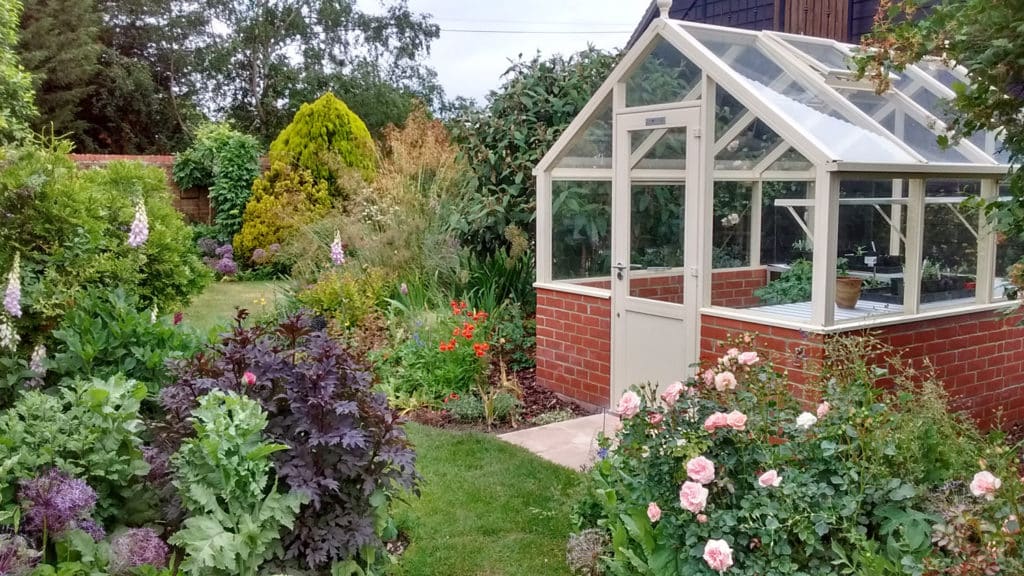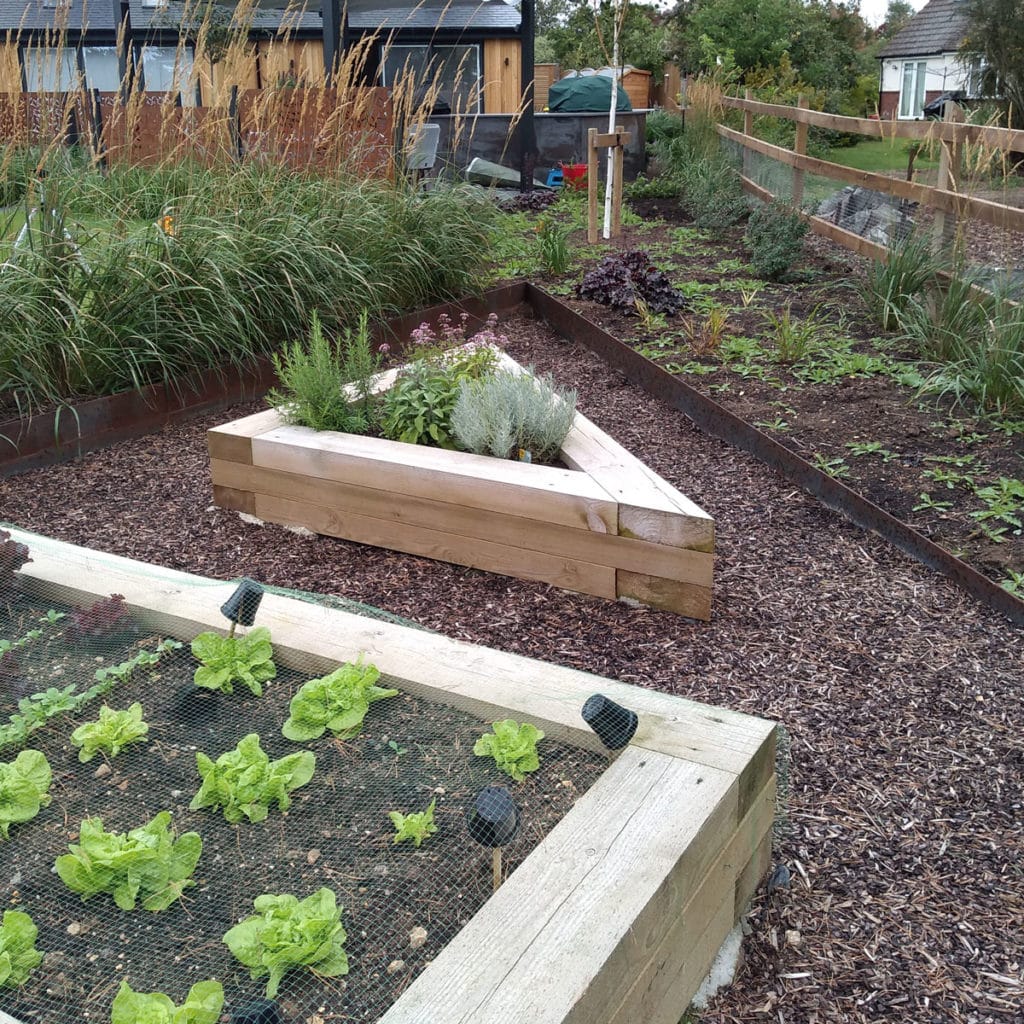23 Mar How Get Your Garden Ready To Grow Your Own Food
Planning to grow your own food this year? Here’s how to prepare your garden.
The recent food shortages in Supermarkets got me to thinking about food security. I don’t want to get all political in a blog, but it seems daft to me that the UK – which has a fabulous climate for growing things – is so reliant on other countries for food. And don’t even get me started on the pollution generated by the planes, trains, ships and trucks that bring our food from all over the world. True, we can’t quite grow pineapples or bananas and getting tomatoes to ripen in winter is very complicated. But there is a really rich variety of seasonal fruits and vegetables that anyone with an outside space can easily grow for themselves.
Raised beds create the ideal environment for growing a wide range of edible plants.
What Do You Need To Grow Your Own Food?
Somebody once said that all you need to grow plants is mud and seeds. That’s not quite accurate, but the basic principal is correct. If you go to a garden centre you’ll be overwhelmed at the choices of tools and equipment available to anyone wishing to grow their own food or flowers. However, don’t be put off; the list of requirements for growing your own food is shorter than you might think.
Good quality soil is essential – if your garden soil is sandy or sticky, you may need to enrich it.
If you are not planning to plant directly into your garden soil, you’ll need some kind of container for your growing medium. It needn’t be fancy – I’ve seem people growing potatoes using strong bin bags as containers.
A means of watering your plants. A watering can is the simplest option but if you’ll be away from home any time, you might want to invest in an irrigation system.
Shelter for tender plants. A greenhouse or polytunnel is ideal but for low growing crops cloches are very useful.
Protection from birds and bugs. Not all veg crops are susceptible to damage from wildlife but for those that are, a simple netting system is far more environmentally friendly than pesticides or poisons.
Seeds and/or young plants. You don’t need to grow every single veg plant from seed. Garden centres and online retailers offer a great range of starter plants. These are great value if you only plan to grow a few of each veg. An average packet of cabbage seeds contains enough seed to grow 200 plants – will your family eat 200 cabbages this year? Bearing in mind that all of them will be ready to eat within about a fortnight of each other.
Getting Your Garden Ready For Food Production
There are hundreds of videos and tutorials online showing you how to sow seeds, nurture seedlings and take the side shoots off your tomatoes. But before you do any of that, you need to prepare your garden. And for that, you may need the help of a professional landscaper.
Start by deciding where your veg patch will sit within the garden and how much space you will dedicate to it. Will you need raised beds? Better soil? An outside tap? Paths? A greenhouse? Does the area need to be cleared before you can make a start?
If the preparation work seems daunting, invest in the services of a landscaper to help you. If not, you’ll struggle to get the results you dream of.
Here’s how to find a trustworthy landscaper.

A good quality greenhouse is a real asset in the productive garden. This greenhouse base was built by Holland Landscapes.
How Can Holland Landscapes Help You To Grow Your Own Food?
Sadly, we don’t have time to run your allotment garden for you. But we can help you adapt your garden so that it’s easy and convenient to grow your own food. Let us know if you need help with any of the following.
Garden Clearance
The Holland Landscapes team have the machines, manpower and energy to clear an untidy garden quickly and efficiently. We will arrange the necessary skip hire and make sure that any waste is taken away for recycling.
Click here for more information about garden clearance
Major soil improvements
We can help you to replace poor quality garden soil with growing medium that’s better suited to growing delicious food crops. Alternatively, we can help you to source and incorporate soil improvers such as compost or well rotted manure.
Greenhouse Bases
Create a controlled environment for plants that like heat and/or humidity by installing a greenhouse. A glasshouse that sits upon a brick base and has a paved floor has lots of advantages over a cheap and cheerful alternative. Brick and stone absorbs heat from the sun and releases stored warmth over night, helping to keep your plants at a nice even temperature.
Polytunnels
My pal absolutely swears by her poly tunnel and manages to grow food in it all year round. They’re a bit tricky to put up though, so if you need help, give us a call.
Raised Beds and Planters
A nice neat way to organise your veg patch and you have full control over the growing media within them. Raised beds are a real asset to anyone who wants to grow food. You can design and build them to any height or shape, meaning that they can be accessible for less mobile gardeners.
Fruit Cages
The Victorians knew exactly what they were doing when they put their soft fruit bushes inside a cage. The mesh is the perfect size to allow pollinators through but keep birds out. My pal with the poly tunnel dreams of having a fruit cage but it’s not birds she needs to deter – it’s her two hungry labradors!
Irrigation Systems
If the last two years are anything to go by, if you want to grow your own food, you will need to water your plants for at least part of the summer. Make it easy for yourself by installing an automated irrigation system. That way, you can head to the beach without worrying about watering your veg patch. Need help? Let us know.
If you are planning a makeover for all or part of your garden, our team of highly skilled landscapers are on hand to advise on any aspect of garden design and build. Simply call or email us to get your project underway.
You May Also Like These Articles
How to build raised beds to grow your own food





Sorry, the comment form is closed at this time.